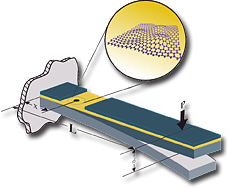Mechanical Properties of Graphene
 Graphene is a two-dimensional crystal, consisting of hexagonally-arranged covalently bonded carbon atoms and is the template for one dimensional CNTs, three dimensional graphite, and also of important commercial products, such as polycrystalline carbon fibres (CF). As a single, virtually defect-free crystal, graphene is predicted to have an intrinsic tensile strength higher than any other known materials and tensile stiffness similar to graphite. In graphitic materials, such as CF, the variation of phonon frequency per unit of strain can provide information on the efficiency of stress transfer to individual bonds. Indeed, the higher the crystallinity of a fibre (and hence the modulus) the higher the degree of bond deformation and, hence, the higher the measured Raman shift per unit strain.
Graphene is a two-dimensional crystal, consisting of hexagonally-arranged covalently bonded carbon atoms and is the template for one dimensional CNTs, three dimensional graphite, and also of important commercial products, such as polycrystalline carbon fibres (CF). As a single, virtually defect-free crystal, graphene is predicted to have an intrinsic tensile strength higher than any other known materials and tensile stiffness similar to graphite. In graphitic materials, such as CF, the variation of phonon frequency per unit of strain can provide information on the efficiency of stress transfer to individual bonds. Indeed, the higher the crystallinity of a fibre (and hence the modulus) the higher the degree of bond deformation and, hence, the higher the measured Raman shift per unit strain.
We examine the mechanical behaviour of graphene flakes under tensile and compressive loadings using a cantilever-beam arrangement with PMMA bars. We have tested two different sample types using this method: i) flakes just supported on a plastic bar and ii) flakes embedded within the plastic substrate. By monitoring the shift of the 2D Raman line with strain, information on the stress transfer efficiency as a function of stress sign and monolayer support were obtained.
In tension, the embedded flake seems to sustain strains up to 1.3%, whereas in compression there is an indication of flake buckling at ca. 0.7% strain. The retainment of such a high critical buckling strain confirms the relative high flexural rigidity of the embedded monolayer.
Researchers involved:
• Otakar Frank
• Georgia Tsoukleri
• Sarah Zehar
Relevant Publications:
- "Subjecting a Graphene Monolayer to Tension and Compression" by G. Tsoukleri, J. Parthenios, K. Papagelis, R. Jalil, A.C. Ferrari, A.K. Geim, K.S. Novoselov and C. Galiotis (Submitted for Publication)
